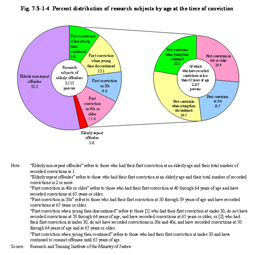| Previous Next Index Image Index Year Selection | |
|
|
3 Elderly non-repeat/repeat offenders and their age at the time of committing offenses Fig. 7-3-1-4 Percent distribution of research subjects by age at the time of conviction This figure reveals that those who had their first conviction at an elderly age but did not repeat offenses (hereinafter referred to as the “elderly non-repeat offenders”) accounted for the majority of 53.3% of research subjects of elderly offenders, while 2.6% had repeated offenses. With those who had not repeated offenses, the reason why they then lived good lives without committing offenses for a long time but then committed an offense for the first time at an elderly age needs to be analyzed. On the other hand, breaking down the punishments against elderly non-repeat offenders reveals that 71.9% accounted for fines. In addition, of those indicted, 22.6% were granted suspension of execution of sentence. And hence merely 5% were sentenced to imprisonment without suspension of execution of sentence, revealing that most offenses committed were minor.Of offenses committed by elderly non-repeat offenders (2,726 persons), by type of offense, injury/assault was the most common (315 persons, 11.6%), followed by Wastes Disposal Act violations (215 persons, 7.9%) and theft (160 persons, 5.9%). With regard to punishment against these offenses, 78.4% (182 persons) for theft, 100% (83 persons) for assault, and 91.6% (197 persons) for Wastes Disposal Act violations were sentenced to fines. On the other hand, 91.9% (147 persons) for theft were sentenced to imprisonment and the rest sentenced to fines. And of the former, 97.3% (143 persons) were granted suspension of execution of sentence while only four persons were imprisoned without suspension of execution of sentence. Section 2 of this chapter attempts to analyze the background and cause of these offenses being committed using the criminal case documents. Those who had their first conviction at an elderly age and repeated offenses (hereinafter referred to as “elderly repeat offenders”) reveal some distinct characteristics, which are described in the next section. Those with recorded convictions at a younger age (hereinafter referred to as “repeated elderly offenders”) accounted for 44.1% of the research subjects of elderly offenders, and of which those who had their first conviction when young and had continuously repeated offenses through their middle age to elderly accounted for 9.8% of the research subjects of elderly offenders (first conviction when young then continued). 62.9% of them were multiple repeat offenders (those with 10 or more recorded convictions). Hence they committed a large number of offenses during their lives and have high offense prone tendencies, and special measures need to be discussed through analyzing their attributes and environment etc, as is carried out in other countries. Nearly half of the repeated elderly offenders had their first conviction in their 30s or 40s (first conviction in 30s or 40s). And as described later, this opposes the general trend in the offense rate decreasing with increased age (refer to “Relationship between Age and Offense Prone Tendency” at the end of this section). Hence a detailed analysis of them, mainly on those who had their first conviction in their 40s or older, is important in understanding how their lives became corrupted in late middle age, etc. With the research subjects of elderly offenders, comparing the type of offense they committed when young and that they committed when elderly reveals a “concordance rate of offenses (tendency to repeat offenses of the same type)” with age in recorded convictions being high for theft, injury/assault, and fraud. The concordance rate of offenses for theft was 28.1% for those of “first conviction when young but then discontinued”, 56.3% for “first conviction when young then continued”, 53.8% for “first conviction in 30s”, and 75.0% for “first conviction in 40s”. Characteristic is that those who continued to commit offenses from when young (first conviction when young then continued) and those who started to commit offenses in late middle age (first conviction in 40s or older) had the tendency to repeat theft, especially remarkable with the latter. In addition, the concordance rate with offenses for injury/assault was 25.0% for those of “first conviction when young then discontinued”, 22.0% for “first conviction when young then continued”, 27.3% for “first conviction in 30s”, and 30.0% for “first conviction in 40s or older”. No such trends with an increasing concordance rate with advancement in age as with theft can be seen with injury/assault. On the other hand, however, regardless of the age at which they had committed injury/assault for the first time, 20 to 30% of them maintained their violent nature into an elderly age. |
